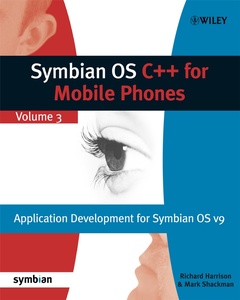Symbian OS C++ for mobile phones. Volume 3 (2nd Ed.)
Auteurs : HARRISON Richard, SHACKMAN Mark

Acknowledgements.
Symbian Press Acknowledgments.
About this book.
Glossary.
1 Getting Started.
1.1 Using the Emulator.
1.2 Hello World Text Version.
Summary.
2 A System Introduction to Symbian OS.
2.1 Symbian OS Basics.
2.2 Framework Basics.
2.3 APIs Covered in this Book.
Summary.
3 Symbian OS C++.
3.1 Fundamental Data Types.
3.2 Naming Conventions.
3.3 Functions.
3.4 APIs.
3.5 Templates.
3.6 Casting.
3.7 Classes.
3.8 Design Patterns.
Summary.
4 Objects Memory Management, Cleanup and Error Handling.
4.1 Object Creation and Destruction.
4.2 Class Categories in Symbian OS.
4.3 Error Handling.
4.4 The Cleanup Stack.
4.5 Two Phase Construction.
Summary.
5 Descriptors.
5.1 Overview.
5.2 Anatomy of Descriptors.
5.3 Literals.
5.4 Stack Descriptors.
5.5 Pointer Descriptors.
5.6 Heap Descriptors.
5.7 Narrow, Wide and Neutral Descriptors.
5.8 Descriptors and Binary Data.
5.9 Using Descriptors with Methods.
5.10 Some Descriptor Operations.
5.11 Correct Use of Descriptors.
5.12 Manipulating Descriptors.
Summary.
6 Active Objects.
6.1 The Asynchronous Service.
6.2 Multitasking and Pre emption.
6.3 A More In depth Look at Active Objects.
6.4 How It Works.
6.5 Active Object Priorities.
6.6 Active Object Cancellation.
6.7 Starting and Stopping the Scheduler.
6.8 Understanding a Stray Signal.
6.9 Other Common Active Object Errors.
6.10 Implementing State Machines.
6.11 Long Running Tasks and Active Objects.
Summary.
7 Files and the File System.
7.1 File Based Applications.
7.2 Drives and File Types.
7.3 File System Services.
7.4 Streams.
7.5 Stores.
Summary.
8 Interprocess Communication Mechanisms.
8.1 Overview.
8.2 Client server IPC.
8.3 Publish and Subscribe IPC.
8.4 Message Queue IPC.
8.5 Which IPC Mechanism Should You Use?
Summary.
9 Platform Security and Publishing Applications.
9.1 Releasing an Application.
9.2 How Does Platform Security Work?
9.3 How Do I Support Platform Security?
9.4 Preparing an Application for Distribution.
9.5 Overview of Symbian Signed.
9.5 Installing a SIS File.
9.6 List of Capabilities.
Summary.
10 Debugging and the Emulator.
10.1 Using the Emulator.
10.2 Emulator Debugging.
10.3 Debugging on a Phone.
10.4 Miscellaneous Tools.
Summary.
11 The Application Framework.
11.1 Symbian OS Application Framework.
11.2 S60 and UIQ Platform Application Frameworks.
11.3 A Graphical Hello World.
Summary.
12 A Simple Graphical Application.
12.1 Implementing the Game on S60.
12.2 Differences for UIQ 3.
Summary.
13 Resource Files.
13.1 Why a Symbian Specific Resource Compiler?
13.2 Source File Syntax.
13.3 Bitmaps and Icons.
13.4 Updating the Resource...
Date de parution : 03-2007
Ouvrage de 416 p.



